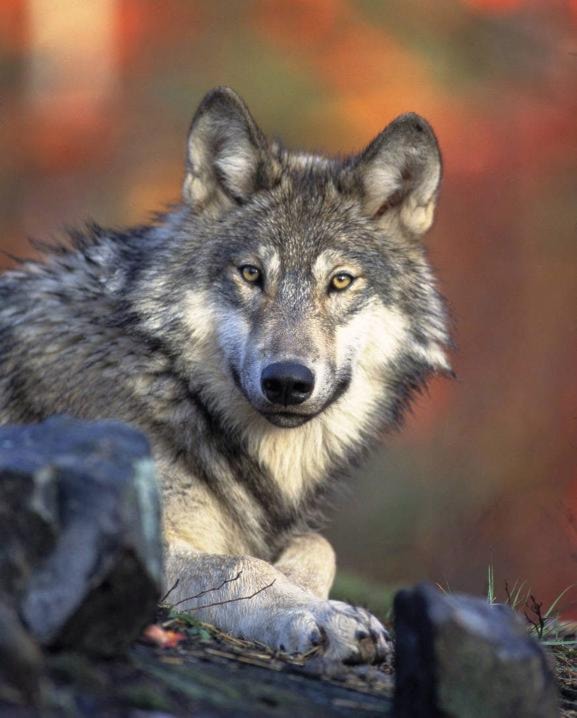Poisoning and shooting more than 900 wolves to stabilize a small caribou herd is destroying the area’s ecology and giving Alberta an international black eye, say Central Alberta conservationists.
“It’s absolutely chilling,” said Bob Scammell, an author and journalist who received the Alberta government’s highest conservation honour, the Order of Bighorn, in 2000.
“It’s an absolute horror story,” added Dwight Rodtka, a retired problem wildlife specialist for Alberta Agriculture.
The men were reacting to a wolf cull that’s been done for the past nine years to try to save a small population of woodland caribou near Little Smoky, just south of Valleyview.
Study results by biologists show killing 841 wolves from 2005 to 2012 has barely managed to stabilize the threatened herd living in a region that’s 95 per cent disturbed by industry. The cull continues and the estimated number of dead wolves is now more than 900. Critics say “collateral damage” to other animals eating the poison is inestimable.
Scammell and Rodtka believe the government is needlessly targeting wolves because it’s unwilling to curb unchecked forestry and energy developments that are destroying caribou habit. Conservationists say all the tree removal has actually caused “wolf highways” to be created into the forest.
The provincial government’s bias towards industry at the expense of the environment is causing the strong opposition to Alberta pipeline projects in B.C. and the U.S., according to Scammell.
“This is what’s causing Alberta’s tremendous pipeline problems. This will be noticed all over the world, especially in the U.S.,” predicted the columnist, whose opinion pieces run in various Alberta newspapers, including the Advocate.
“People will say, ‘We don’t want that sort of stuff happening here’ — and the Alberta government just doesn’t get it.”
The Little Smoky herd is made up of only about 70 caribou — a protected species that cannot be hunted in the province. The animals are managing to exist on land near the Little Smoky River that’s scarred by forestry cut blocks, seismic lines and other energy developments.
After all the effort, including killing 200 moose and elk for poisoned bait, Rodtka said hardly any more caribou calves are being produced compared to nine years ago. Meanwhile, he believes the culling program will likely trigger remaining wolves to produce larger litters as natural compensation.
The scientific report compared herd numbers before and after the cull and found the population has barely crept up. While killing wolves has stopped caribou decline, the herd is not significantly growing.
Prompted by a mandate from Ottawa to keep the emblematic Canadian animal from disappearing, the Alberta government embarked on the annual cull of 45 per cent of wolves in the area northwest of Edmonton. Besides being shot from helicopters, wolves are being killed with poisoned carcasses left in the forest.
Conservationists are alarmed this approach is eliminating biodiversity in the region, as many other smaller animals, including eagles, ravens, foxes, fishers and other scavengers are also eating the poisoned meat — as reported by in a recent article in Alberta Sportsmen Magazine. “It sends shivers up my spine. ... It’s an absolute disaster,” said Scammell.
Jim Robertson, executive director of the Waskasoo Environmental Education Society, doubts the cull will do any long-term good. “It’s a people problem, not a wolf problem,” he said, noting such culls have historically caused problems in Banff and around Yellowstone National Park in Wyoming, tipping the natural balance. He warned that better habitat protection would yield better future benefits.
But Duncan MacDonnell, a public affairs officer for Alberta Environment and Sustainable Resource Development, believes the provincial government is doing its best to comply with a federal mandate to protect a threatened species. “After years of population decline, the program has managed to maintain caribou survival,” he added — so it has been a success.
“We want to keep caribou in the landscape.”
He hasn’t heard anything about the collateral poisoning of other forest species. And he doesn’t know if other provinces are culling wolves to protect their caribou, saying “I have no idea. We have enough to worry about with the complexities of this problem here.”
Comparisons to past wolf culls in Yellowstone and Banff are not useful, according to MacDonnell, since these were meant to help elk, “and they are nothing like caribou” — which are considered complex animals with lower reproductive rates.
The provincial government isn’t ignoring the impact of industry, he maintained. MacDonnell suggested a more comprehensive, sustainable approach to keeping caribou herds in Alberta will be presented in a wide-ranging plan due in 2017.
The first part, dealing with the Little Smoky herd, is expected by next year. “It will deal with the whole picture and look at all factors in caribou survival,” said MacDonnell.
Meanwhile, he stressed the government is not removing all wolves, but needs to decrease caribou mortality until a more comprehensive approach can be adopted.
lmichelin@www.reddeeradvocate.com
